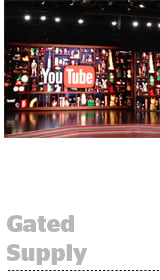 Google’s plan to rival Netflix and Hulu by introducing its own ad-free subscription service has left some questioning as to whether it will restrict content creators enough to move elsewhere.
Google’s plan to rival Netflix and Hulu by introducing its own ad-free subscription service has left some questioning as to whether it will restrict content creators enough to move elsewhere.
Although YouTube creators will receive a 55% cut of paid subscription revenue for their videos, which is equal to the percentage they earn for pre-roll ad revenue on the free service, the jury is out on whether a pay wall would ultimately clean up Google’s video environment or add an additional barrier of access to advertisers who want to align with premium creator content.
“Advertisers are already launching increasingly fragmented campaigns to hit their campaign audience targets, and now Google is squeezing out some of the supply they rely on,” said Frank Sinton, CEO of Beachfront Media, a video ad tech platform serving brands, publishers and agencies. “I don’t think this hurts advertisers as much as it could hurt Google, who could very well see droves of advertisers reallocating campaigns off YouTube as a result of the shrinking and fragmented supply on YouTube.”
Mike Henry, CEO of Outrigger Media, a platform used by brands and agencies to target brand-safe YouTube inventory, said that even if YouTube’s paid subscription service is wildly successful, he doesn’t foresee it putting a dent in ad inventory because of YouTube’s overall scale.
“However, you could argue that it might become harder to reach older or more affluent viewers, since they’re the ones more likely to pay up,” he added.
Google is asking YouTube partners who utilize its free service to also include videos for the subscription service, Re/code reported. YouTube would allegedly classify those videos as private if they don’t, which could foreseeably obstruct searchability in the free environment.
“Imagine being a long-tail creator with 50,000 fans who predominantly [relied on advertising],” Sinton added. “The new paid subscription revenue [could come] at the expense of the core ad revenue. In an effort to compete with off-YouTube creator hubs, Google may well be pushing creators right to them with this move.”
YouTube’s creators now have other options.
It faces competition from all corners, including ex-Hulu CEO Jason Kilar’s new offering, Vessel, as well as Amazon’s rumored video-streaming service and a “platform-agnostic” sensibility from popular creators like Michelle Phan, who’s launching her own network dubbed Icon in partnership with digital network Endemol.
Multichannel network Whistle Sports, a company that works with popular YouTube stars to create and promote interactive sports content to some 15 million fans and subscribers, is in discussions with YouTube and Vessel for both ad-supported and subscription-based distribution, according to CEO John West.
“Hulu and Hulu Plus have proven there’s clearly a market for that, if done well and authentically,” West said. “I do think there is a certain subset of our audience – the superfans – who certainly may pay for window-gating of content or freemium content, but more than anything, we’re seeing a migration toward socially consumed video.”
West said that in addition to the creator-to-community conversation that YouTube favors, the younger end of its millennial demographic (ages 13–24) prefer short-form video discovered on platforms like Facebook, Twitter/Vine and Snapchat.
“Just how they migrated from TV to digital and YouTube, we now see they’re migrating across social platforms,” West said. “Our audience is twice as large on Facebook now as it is on YouTube.”
















